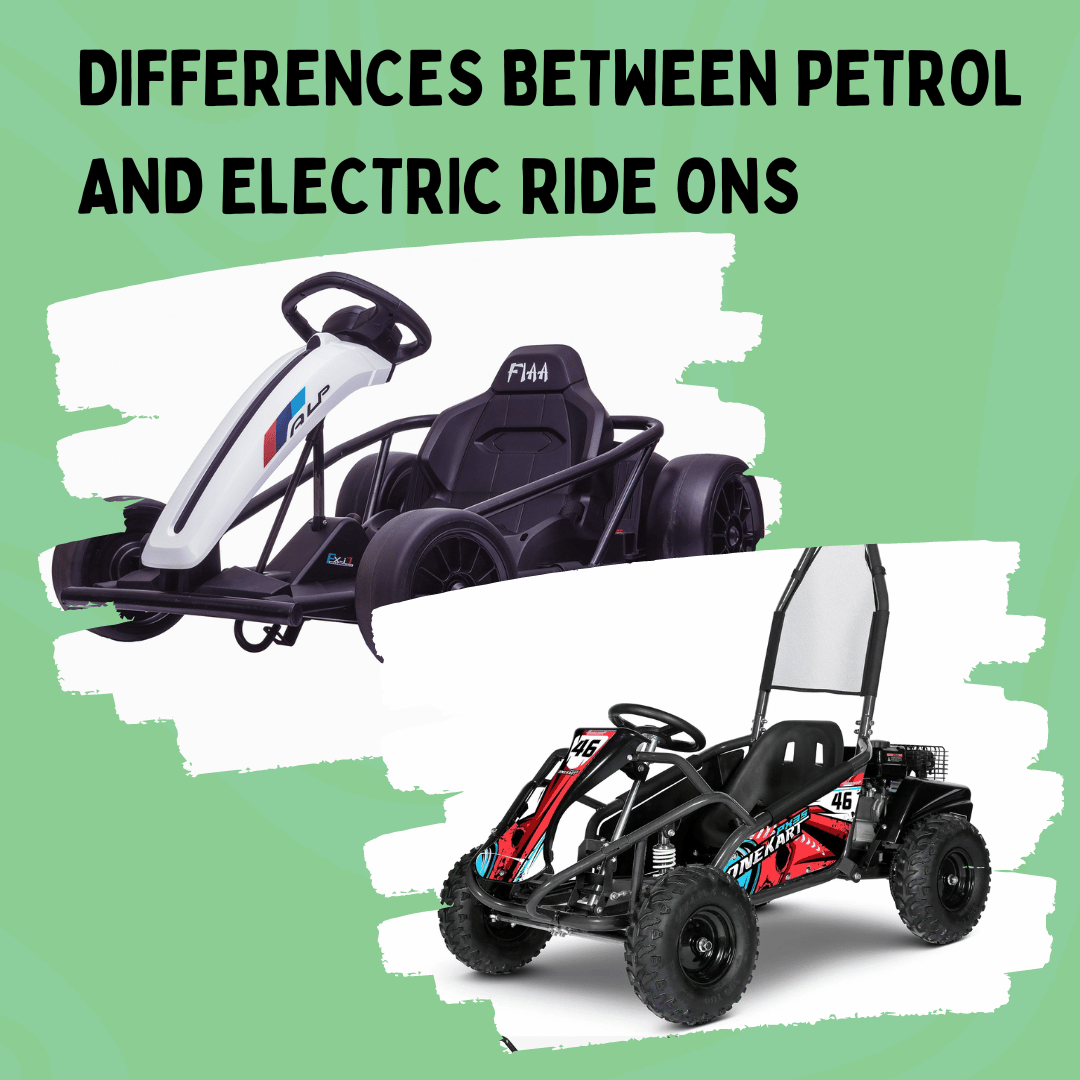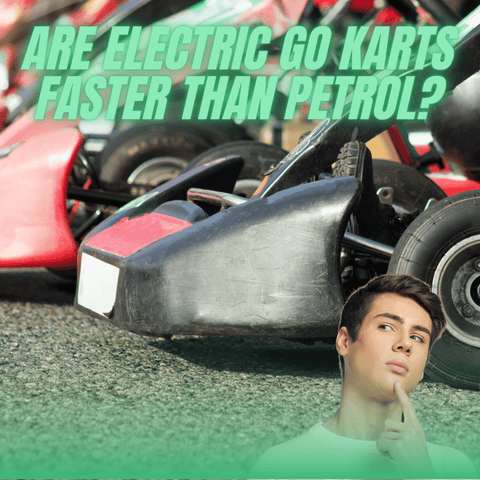Every child dreams of zooming around on their personal ride-on car.
Whether it's a quad bike, a dirt bike, or a drift-kart, these playthings provide a thrill like no other. 
But did you know that the type of power source, either petrol or electric, can make a significant difference in their ride-on experience?
What Exactly Are the Differences Between Petrol And Electric Ride Ons
Petrol and electric ride-ons each come with their unique attributes. Petrol ride-ons, powered by internal combustion engines, are traditionally favoured for their raw power and classic driving experience. However, they emit pollutants and require frequent maintenance. On the other hand, electric ride-ons, powered by efficient electric motors, are quiet, economical, practical, and eco-friendly, providing kids a safe and fumeless driving experience. Despite being cleaner and quieter, they don't compromise on power, offering a potent punch of instant torque right from a standstill.
Power Source
First, let's explore the power source of these machines.
Petrol Ride Ons
Also referred to as Gasoline/Petrol Ride Ons or Combustion Engine Ride Ons, petrol ride-ons run on internal combustion engines.
They convert the energy of petrol into motion, providing an authentic mini-driving experience.
Electric Ride Ons
On the other hand, Electric Ride Ons, also known as Battery-powered Ride Ons or Electric Engine Ride Ons, run on electricity.
They deliver a smooth, quiet ride, making them ideal for residential areas.
Emissions
It's no secret that petrol ride-ons produce carbon dioxide emissions, contributing to air pollution and climate change.
In contrast, electric ride-ons produce zero exhaust emissions, aligning with global sustainability and eco-friendly goals.
Related: Eco-Friendly Practices: Recycling Old Toy Car Batteries
Noise
An essential element to consider is the noise level. Petrol ride-ons generate more noise due to their engines. However, electric ride-ons are noticeably quieter, offering a peaceful ride and causing less disturbance to the surroundings.
Maintenance
Maintenance is another critical factor. Petrol ride-ons, with their complex engines and multiple moving parts, require regular maintenance like oil changes.
Electric ride-ons, with fewer moving parts, need less upkeep, making them more practical and user-friendly.
Refueling/Charging
Refuelling a petrol ride-on at a petrol station can be time-consuming.
Electric ride-ons, however, can be easily charged at home or at public charging points, adding to their convenience.
Acceleration
When it comes to acceleration, electric ride-ons often provide instant torque, meaning they deliver quick acceleration from a standstill.
Petrol ride-ons may require revving the engine to access their full power, a factor to consider depending on the child's skills and experience.
Gearbox
Electric ride-ons usually have automatic gearboxes, making them easy to handle for kids.
Petrol ride-ons offer both manual and automatic gearboxes, providing a more immersive but complex experience.
Running Costs
Running costs can also influence your choice. Electric ride-ons are often more economical.
Electricity tends to be cheaper than petrol, and electric motors are more energy-efficient.
Furthermore, these ride-ons often qualify for incentives and require lower maintenance costs.
An important aspect to note, however, is understanding your ride-on's charging process and how long it usually takes to charge a ride-on toy.
Different Ride-On Examples
Many ride-ons come in both petrol and electric versions. These include:
Ride-On Cars
One of the most popular choices for kids, ride-on cars offer a realistic driving experience.
These come in a variety of models, from sleek sports cars to rugged off-roaders, in both petrol and electric versions.
Motorbikes
Ideal for the little thrill-seekers, motorbikes offer an exhilarating ride.
Whether it's a petrol-powered mini chopper or an electric cruiser, these two-wheelers provide endless outdoor fun.
Quads/ATVs
Also known as Kids Quad Bikes, these four-wheeled machines, whether petrol-powered Children's ATVs or electric Youth Quad Bikes offer fantastic off-road adventures.
These are perfect for explorative kids who love outdoor escapades.
Dirt Bikes
From petrol-powered Off-road Motorcycles to electric All-terrain Bikes, these nimble machines cater to adrenaline junkies.
Their robust build and rugged performance make dirt biking a favourite outdoor activity.
Pit Bikes
Pit bikes, smaller versions of dirt bikes, are designed for racing around pits.
They are available in both petrol and electric models, providing an excellent introduction to the world of motorsports for kids.
Go-Karts
Go-karts offer a unique four-wheeled, fun ride. Available in both petrol and electric variants, these karts give children a thrilling experience of racing on tracks or even in the backyard.
Drift Karts
Also known as "Drifting Go Karts", these ride-ons offer an exciting sliding experience around corners.
Whether it's a petrol-powered Drift go-kart or an electric motorised drift kart, these three and four-wheelers promise a unique, fun-filled adventure on the pavement.
Related: Are Electric Go Karts Faster Than Petrol?
Safety Considerations
Helmets, knee and elbow pads, and adult supervision should always accompany ride-on playtime.
Understanding the role of helmets and protective gear can provide a safer environment for your children.
Safety is paramount when it comes to ride-on toys, whether petrol or electric.
With both types offering their unique sets of safety attributes, it's crucial to understand these differences to ensure a safe riding experience for your child.
Operational Safety
Petrol ride-ons, being powered by combustion engines, may pose safety concerns related to fuel handling and potential overheating.
On the other hand, electric ride-ons pose their safety challenges, too, such as the proper handling of batteries, especially during charging to prevent any risk of electric shock or overheating.
Safety Features
Both petrol and electric ride-ons come equipped with safety features to enhance secure rides.
For instance, seat belts, roll bars, and even speed control options are commonplace in these rides.
However, electric ride-ons often provide additional safety controls like parental remote controls, enabling parents to take over the ride-on's operation if needed.
Precautions
Petrol ride-ons require careful handling of fuel, maintaining a safe distance from fire sources, and ensuring the engine is off while refuelling.
They may also require careful monitoring to avoid overheating the engine.
For electric ride-ons, precautions primarily revolve around battery care.
It's essential to avoid overcharging the battery and ensure it's kept away from water or extreme temperatures.
Life Expectancy of Ride-Ons
When it comes to the lifespan of ride-on toys, it's not just the initial cost that matters.
The life expectancy of the product can significantly affect the overall value you receive from your purchase.
Petrol Ride-Ons
Petrol ride-ons, due to their robust engines and durable construction, can offer extended lifespans.
However, they require regular maintenance, and their life expectancy significantly depends on how well they're maintained.
Electric Ride-Ons
Electric ride-ons, while requiring lesser maintenance, depend heavily on their battery life.
The average battery lifespan is around 3-5 years. However, good care and proper handling can potentially extend this period.
Future Prospects
Looking into the future of ride-ons, there's a clear trend towards more sustainable and tech-advanced options.
Petrol Ride-Ons
While petrol ride-ons have been around for a long time and have a classic appeal, environmental concerns and advancements in electric technology might pose challenges to their popularity in the future.
Electric Ride-Ons
Electric ride-ons are riding the wave of technological innovation.
With advancements in battery technology, and increased emphasis on environmental sustainability, electric ride-ons are poised to become even more popular in the future.
Furthermore, the potential integration of smart features could make these ride-ons more interactive and safe.
Conclusion
In conclusion, both petrol and electric ride-ons have their merits and demerits.
It's essential to consider these differences, taking into account factors such as environmental impact, convenience, cost, and the child's capability.
With the right choice, your child can have the thrill of a lifetime while you have peace of mind.
FAQs
How does the driving experience differ between petrol and electric ride-ons?
The driving experience between petrol and electric ride-ons can be quite distinct. Petrol ride-ons often offer a more traditional driving experience with engine noise and vibration, which some people find satisfying. In contrast, electric ride-ons offer a quieter, smoother ride, which can make for a more comfortable driving experience, especially for longer durations.
What are the environmental impacts of using petrol vs electric ride-ons?
Petrol ride-ons contribute to air pollution due to emissions produced by their combustion engines, including CO2, which contributes to global warming. In contrast, electric ride-ons have zero tailpipe emissions, making them more environmentally friendly. However, it's essential to consider the source of electricity used to charge electric ride-ons; renewable sources significantly lessen the environmental impact compared to fossil fuel-generated electricity.
Are quad bikes petrol or diesel?
Quad bikes, also known as ATVs (All-Terrain Vehicles), are typically powered by petrol. However, electric versions of quad bikes have been gaining popularity in recent years due to their eco-friendliness and lower maintenance needs. Diesel quad bikes are less common, as diesel engines are generally heavier and more suited to larger vehicles.
Ready to Make the Switch to Electric?
We hope this article has given you a clearer understanding of the differences between petrol and electric ride-ons.
Armed with this information, you are now better equipped to make the best choice for your child's next thrilling adventure.
At RiiRoo.com, we offer an extensive range of ride-on toys, including both petrol and electric options.
We understand that deciding on the perfect ride can be a bit challenging. Therefore, our dedicated team is always ready to guide you through our collection and help you make the most suitable choice based on your specific needs and preferences.
Found this article useful?
Please don't hesitate to get in touch with any further questions or concerns you might have about kids' ride-on toys.
We're just a Live Chat or an email away.
You can reach us at hello@riiroo.com. We look forward to helping you bring a joyful ride-on experience to your little one!
Your child's fun, unforgettable ride-on adventure starts here at RiiRoo.
Additional Resources
For more information on various types of ride-on toys, you can explore the following resources:









Share:
What Are the Best Go-Kart Gear Ratios? (UPDATED 2025)
Does Go Kart Racing Have Pit Stops?